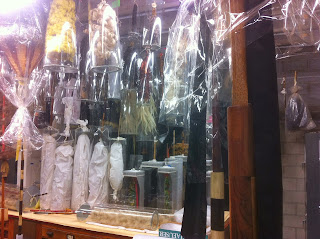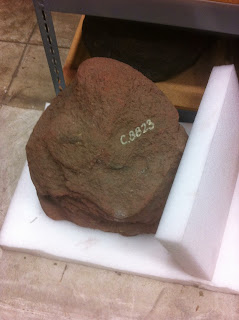Happy Aloha (Museum) Friday! I have a special one for you today! The archaeology conference is going on at Bishop Museum this weekend and they had a few tours today offered for those that reserved a spot ahead of time. Mahalo to Nicole Ishihara for sending me the link to the event on my comments.
There were other tours hosted by Bishop Museum. One went to the Koolau district to view places like He'eia and another went to the North Shore. The other option was a tour behind the closed doors of the museum's anthropology department. Although I wouldn't mind to have went to the north shore or the Koolau's with some people with better insight of the sights there, I've been wanting to get into the anthropology department for some time now.
The artifacts on this image are from Nu'alolo Kai. An ancient fishing village that was well preserved on the Napali Coast of Kauai. A lot of the specimens left out for us to see on the tour
were from this area.
Laid out beside them were artifacts from Emory's class study of Kuli'ou'ou Rock Shelter. A couple of the other well informed people were interested in what looked like a scraper made from a jawbone of a pig. On the bottom left.
I'm unsure where this tray of artifacts originated from. The piece on the bottom right looks like my friend Kyle's clothing brand Morals Fiber and the short staff on top looks to me like it's Kau'ila wood.
This remarkable disc is a stone mirror. It's said to have been found in Kauai and has no connection with any stone material found in Hawaii. It's suspected to have been brought here from somewhere else long ago. The user would have placed it in a larger stone bowl full of water and looked down into it as it reflected. Or simply adding water to the surface of the stone disc itself would also work as easy and similarly as a woman's pocket mirror...
Here is another item that is not found anywhere else in the Hawaiian archipelago. A stone pohaku from Moanalua Valley with two humanoid petroglyphs protruding outward from the stone. Instead of carved into the rock like almost every Hawaiian petroglyph.
I have been searching for this stone ever since I started reading up on Hawaiian history and saw its image in books years ago. One book stated that it was simply left in the courtyard of Bishop Museum and during my first return to the museum since childhood, I looked everywhere for it. Pushing bushes and leaves to the side, and crawling next to the walls of the buildings in search of it....
Here is a well preserved tapa from the Nu'alolo Kai site. Our guide Victoria mentioned how they would sometimes find old tapa debris floating down from the cliffside. Possibly from birds living in burial caves and disturbing the remains until they finally get pushed off the cliff. Another person mentioned finding a small nest made of some sections of the old tapa gathered by some resourceful bird...
Just a few of the kahili they have in their collection...
I have no idea what this is. Looks like a very elaborate coat hanger but I'm sure I'm totally clueless.
This red pohaku managed to get indoors to this room but I have no explanation for it as well. Some Heiau sites are said to have contained key stones that were red like this. Like at Waha'ula Heiau on Hawaii island. That one was covered by lava in recent times. Could this be a rescued pohaku from before the lava flow? I should have asked...
There were a couple of three level shelves with all types of stone artifacts on them. Some anchors, lamps, bowls. The trippy part was when our guide told us to put our cameras away as she uncovered a shelf full of stone Ki'i like those found on Nihoa Island and on display inside the museum. There were also others that had their own individual human face or entire body. She said, "they like to rest" and mentioned that she gets the goosebumps every time she's near them. That kind of freaked me out. Wish I could share an image with you but I didn't want to be disrespectful or even risk a small sample of what she was hinting at...
This shell bracelet from Niihau is a preview of a new display to be placed in the museum.
Here are some stone adze followed by some pohaku ku'i from all over Polynesia.
Some Pohaku ku'i were made of coral or even stalactites...
Horrible pic but this one had a face on the top.
Finally we made our way to the Malacology Department. A gentleman there explained the distribution of land snails in Polynesia and how they can be used to tell what the environment was like during the snail's lifetime. The smallest and most abundant ones were able to be carried by birds across the ocean. But one species seems to have been able to be found on only a select few islands across the Pacific and suggested human distribution...
These snails were preserved with the meat inside...


















































